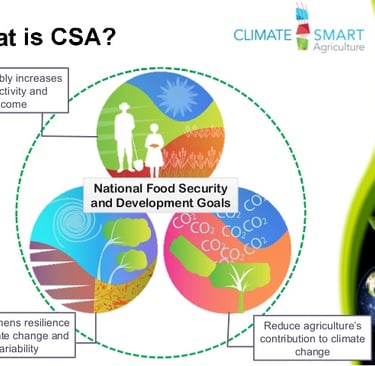Policy Frameworks Supporting Climate-Smart Agriculture in India
As India grapples with the dual challenge of ensuring food security and combating climate change, Climate-Smart Agriculture (CSA) has emerged as a vital strategy to make farming more resilient, productive, and sustainable. To enable this transition, India has developed a range of policy frameworks that align agricultural development with climate resilience and environmental sustainability.
HawkEye
5/21/20251 min read


What is Climate-Smart Agriculture?
Climate-Smart Agriculture, aims towards:
Sustainably increase agricultural productivity
Enhance resilience (adaptation) to climate change
Reduce greenhouse gas emissions where possible
CSA includes technologies like precision farming, water-efficient irrigation, integrated pest management, weather-based advisory systems, resilient crop varieties, and agroforestry.
Key Policy Frameworks Promoting CSA in India
1. National Action Plan on Climate Change (NAPCC)
Launched in 2008, the NAPCC is India’s overarching climate policy, comprising eight missions. Among them:
National Mission on Sustainable Agriculture (NMSA):
Focuses on climate-resilient agriculture through soil health management, efficient irrigation, and agroforestry.
2. State Action Plans on Climate Change (SAPCCs)
Each state in India develops its own climate strategy under NAPCC’s framework, adapting CSA principles to local needs. SAPCCs provide funding, monitoring, and coordination for regional CSA implementation.
3. Pradhan Mantri Krishi Sinchayee Yojana (PMKSY)
Promotes ‘More Crop per Drop’, encouraging efficient water use through micro-irrigation and watershed development—core principles of CSA.
4. Soil Health Card Scheme
Launched in 2015, this scheme helps farmers reduce excessive fertilizer use by providing customized soil reports. This improves yields while lowering emissions—a CSA-compatible approach.
5. Paramparagat Krishi Vikas Yojana (PKVY)
Encourages organic farming and traditional methods with a climate focus. Promotes soil carbon sequestration and avoids harmful agrochemicals.
6. National Agroforestry Policy (2014)
India became the first country to adopt a national agroforestry policy. Agroforestry enhances carbon capture, diversifies farmer income, and restores degraded lands.
7. MGNREGA for Climate Resilience
Through watershed development and soil conservation work, MGNREGA supports climate-smart rural infrastructure and complements CSA on a community scale.
8. Mission for Integrated Development of Horticulture (MIDH)
Promotes sustainable practices in horticulture with CSA linkages like drip irrigation, polyhouses, and resilient planting materials.
The Way Forward, To truly scale CSA in India, the following strategies are essential:
Strengthening convergence across policies and schemes
Capacity building of extension workers and farmers
Incentivizing climate-smart inputs (e.g., solar pumps, drought-resistant seeds)
Integrating indigenous knowledge with scientific research
Public-private partnerships to accelerate innovation and outreach
Conclusion
India’s policy ecosystem is increasingly aligned with climate-smart agriculture goals. With proper implementation, funding, and farmer engagement, these frameworks can transform Indian agriculture into a climate-resilient, sustainable, and inclusive engine of rural development.
#ClimateSmartAgriculture #Policy #Sustainability #IndianAgriculture #ClimateAction
